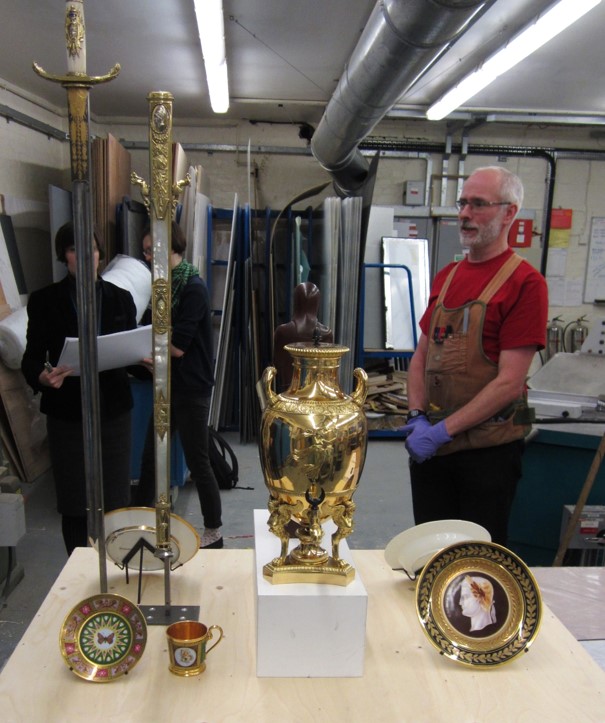Many of the 1000+ objects are going in to the new Europe Galleries will require support in order to ensure they are displayed safely. This support will be in the form of custom-made mounts. Mounts can be required for a variety of practical and aesthetic reasons:
- To support fragile or weak objects
- To enable objects to be displayed on a vertical plain (i.e. so that they don’t have to simply ‘sit’ on a horizontal surface).
- To secure objects against theft
- To prevent vibration affecting the safe positioning of an object e.g. ‘walking’
- To allow an object to be displayed to its best advantage e.g. enabling an important aspect of it to be viewed more easily
- To position an object in a way that increases the visual coherency of a display
All of the mounts used in the Europe Galleries will be designed to preserve the condition of the objects, optimise their display and maintain security. The majority of them will be made in-house, by the very skilled Mount Making Team from our Technical Services Department. A small number of the larger and more specialist mounts will be made by outside contractors, to specifications provided by our mount-makers and ZMMA (the gallery designers).

The design of the mounts is very thoroughly considered, with the aim for them to be as visually unobtrusive as possible so as to not distract from the objects being displayed. In essence, a lot of thought and effort is put into to creating objects that aren’t really meant to be seen!
Each mount will be custom-made for the object it will support. However, efforts are made to somewhat standardised their style and structure to help ensure a sense of cohesive visual design throughout the galleries. There will be some types of mount (such as plate-stands) that will be used throughout the galleries and so a standardised basic design is developed, which then needs to be assessed to make sure that it will be suitable to use in all instances. For example, a plate-stand design could work particularly well in a display on Neoclassicism but perhaps look conspicuous or out of place in a display on Dutch Domesticity.
As with nearly all aspects of creating the new galleries, it is crucial for us to work together to balance the design brief and vision for the gallery displays with the conservation and security requirements for each object. It is important to be clear about who is responsible for making final decisions on the different elements of a design – Curators, Conservators, Technicians or Designers.

The photographs used in this blog entry were taken at a recent session we held in the Museum’s mount-making workshop. We were looking at some prototype mounts that the Museum Techs had created for some of the objects going into our display about Napoleon (the objects shown here reflect the influence of Napoleon’s Egyptian campaigns on French art and design). The Techs talked Curators, Conservators and the Gallery Designers through the practicalities of the current mount designs. They explained any difficulties they had found in the process of making them and also made suggestions for possible variations.

The board that the objects are sitting on is the exact same size as the display space available in the case.

With cases that can be viewed from more than one side, attention needs to be given to what objects and mounts will look like when viewed from behind. In the background here, you can also see Adam from ZMMA (the Gallery Designers) seeming particularly pleased at the look of the mount for the sword.

The designers’ aim is for mounts to interfere with the appearance of the objects as little as possible. Roger has managed to produce a very small inconspicuous clip to hold the sword just below the hilt. The main structure of the mount has strong, clean lines and crisp edges – and was thought to fit well with the overall vision for the gallery. The surface of the final mount will also be treated to make it look neater and more ‘finished’ than it appears here.

Consideration also needs to be given to where and how the mounts are supported or secured. Here, the vertical mount for the sword and scabbard will need to be attached to the base of the case, though the fixings will not be visible to visitors in the final case design. Different mounts will use a variety of attachment methods – some of which may require special fixings or need walls and floors to be reinforced.

The Technicians have created a plate-stand design with ‘hooks’ on the front so small they are barely noticeable but that will still hold the plate securely. The same basic design will be used throughout the galleries but with each stand made bespoke for a specific object.

Above you can see a statuette of an Egyptian figure standing proudly (with its back to a silver-gilt hot-water urn) raised up on a custom-made block. A number of objects in the galleries will be displayed on blocks. Unlike mounts, blocks do not offer any additional support to objects but are instead used to visually benefit their presentation and the appearance of the overall display. Blocks are useful for dealing with differences in scale and size of adjacent objects, helping objects to look more comfortable together. They can introduce visual variation to a display, helping to avoid a possible lacklustre repetition of objects all sitting on one visual plane. They can also provide what could be termed ‘visual punctuation’ – giving objects some ‘breathing space’ and enabling them to be considered individually whilst still being part of a coherent group.

